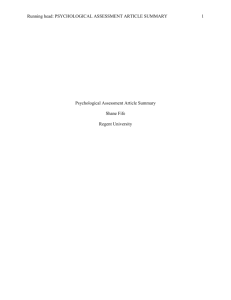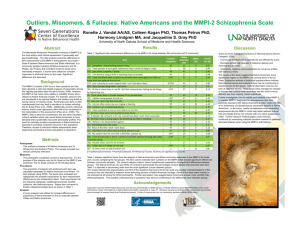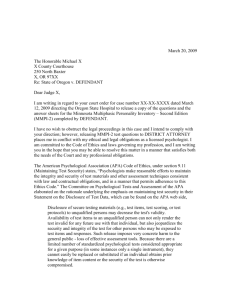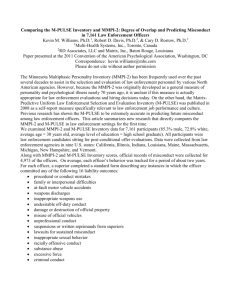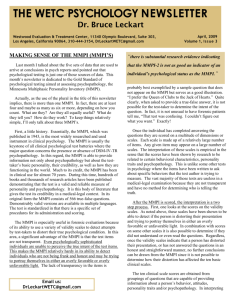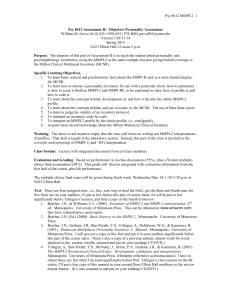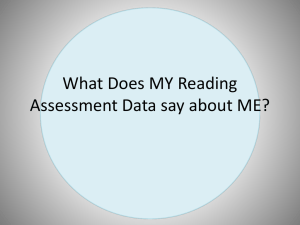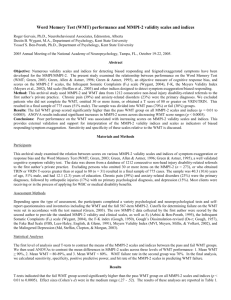MMPI-2 Psychometric Considerations
advertisement
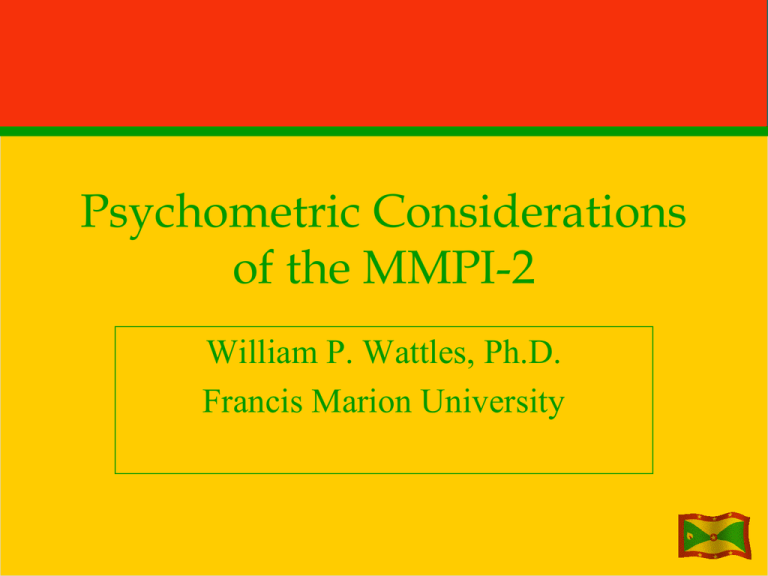
Psychometric Considerations of the MMPI-2 William P. Wattles, Ph.D. Francis Marion University • MMPI/MMPI-2 second most widely used test by clincical psychologists (86%) • Translated into more than 50 languages Original MMPI • Published 1943 • Paper and pencil improvement on clinical interview and individual psychological testing Prior to MMPI: Logical Keying • Test items generated rationally based on: – Face validity – Subjective judgment • Logically keyed items problematic: – Subject to faking – Not always correct Face Validity • Does the test appear to measure what it is purported to Measure? Face Validity 0 I do not feel sad. 1 I feel sad. 2 I am sad all the time and can't snap out of it. 3 I am so sad or unhappy that I can't stand it. • 70. I am easily downed in an argument • 89 My hardest values are with myself • 267 I have periods in which I feel unusually cheerful without any special reason. • 219 I have been disappointed in love Empirical Keying • Original items came from many sources. • Pool of 1,000 items reduced to 566 • Rewritten to be less formal and allow for some reversal of responses. Control Group • 724 Visitors to the hospital in Minnesota. • Representative of Minnesota in the 1930s – – – – – 16-65 Average age mind 30’s Rural 8th grade education White Empirical Keying • Using groups of diagnosed patients • Contrast and Cross-validation MMPI vs MMPI 2 • Improved norms • Score has meaning only when compared to a representative sample. • Original sample Caucasian, 35, married, small town, good job. • New sample large and more representative. • Higher education level than population MMPI-2 normative group • 2600 Participants • Paid $15 ($40 for couples) • Tested in 7 locations – Minnesota, Ohio, North Carolina, Washington, Pennsylvania, Virginia, California • Selected from phone directories MMPI-2 composition • 2600 Participants (started with 2900) – 1138 men – 1462 women • Age 18-85 (M=41, SD=15) • 61% married • Education 3-20 years (M=14, SD=2) MMPI-2 Restandardization • • • • • Caucasian 81% African-American 12% Hispanic 3% Native-American 3% Asian-American 1% Requirements • Eight Grade reading level required • Satisfactory cooperation and commitment to task • Internal checks for the above T Score transformations • Transforming a score makes it easier to interpret. • 13 validity and clinical scales converted to T scores • T score is a standard score with a mean of 50 and a standard deviation of 10. • Thus, a 70 is like a Z score of 2 Standard Scores or Z scores • Z score: how many standard deviations a score lies above or below the mean. 68% 95% 99.7% 46 Percent of scores falling below Z score 3 2 1 -1 -2 -3 % below 99.9% 97.5% 84.0% 16.0% 2.5% 0.1% % within 99.7% 95.0% 68.0% 99.85% 97.5% 84% 46 Z-score z x 33 MMPI-2 T score t 50 10( x ) 33 MMPI Uniform T score • Original linear Tscores were problematic because the underlying data is somewhat skewed. • Thus a T score on one scale represented a different percentile than one on another scale MMPI Uniform T-scores • Involve averaging of the T-scores across the scales. Frequency high points in contemporary settings Scale 1 2 3 4 6 7 8 9 Males Females linearT uniform T linearT uniform T 5.2 4.7 6.3 4.2 21.6 13.8 15.7 15.7 3.4 3.9 3.7 6.3 10.3 12.9 11.5 13.6 18.5 18.5 23.6 28.3 4.7 8.6 2.6 3.1 29.3 29.3 29.8 19.9 6.9 8.2 6.8 8.9 T-score cutoff • Formerly T-scores of 70 were considered clinically significant. Now the MMPI-2 recommends 65. • That puts the score above 93% of those who answer – 65-50/10 = 1.5 – 1.5 = .9332 area under standard normal curve to the left of Z = 1.5 Intercorrelations • There is considerable overlap between some scales. 13 of 39 items in scale 6 also appear in scale 8 Homogeneity of items • The empirical keying approach did not favor item homogeneity thus internal consistency is not high. Temporal Stability • Ability, interest and aptitude tests should be high in temporal stability • Personality and psychopathology measures less clear. Test-retest reliability one week Scale L F K 1 2 3 4 5 6 7 8 9 0 Males (82) Females 0.77 0.78 0.84 0.85 0.75 0.72 0.81 0.82 0.67 0.89 0.87 0.83 0.92 (111) 0.81 0.69 0.81 0.85 0.77 0.76 0.79 0.73 0.58 0.88 0.8 0.68 0.91 Test-retest reliability • Summary. Test is fairly stable and changes when current appear consistent. Significant changes generally correctly reflect behavior change. Internal consistency • Moderate, not a strength for the MMPI-2 due to empirical keying approach. Factor Analysis • Two strong factors identified – General maladjustment and psychotic thought – Neurotic characteristics Response sets and styles • Charges that MMPI and MMPI-2 were confounded by response style. • Block modified MMPI to have equal number of true and false items • Test seems to be valid in a variety of settings. MMPI vs MMPI-2 • Validity similar • Raw Scores higher on MMPI-2 – May be explained by instructions • T-scores compensate for higher raw scores Items changed MMPI-2 Basic Qualifications for users • Graduate-level course in psychological testing. – – – – Standard scores Transformations Understand limits of accuracy Standard error of measurement Basic Qualifications for users • Graduate-level course in psychopathology – – – – – Personality structure Dynamics Deviance psychodiagnostic concepts Diagnostic systems Broad understanding of human personality Lexile Reading Levels in SIRS What Are Lexile Reading Levels • • Lexile scores match reader ability and text difficulty, allowing individualized monitoring of student progress. Due to the accountability requirements of NCLB, many states are turning to standardized systems for reading which help to track student progress. How does it Work? • Lexile measures are based on two wellestablished predictors of how difficult a text is to comprehend: semantic difficulty (word frequency) and syntactic complexity (sentence length). Lexile Score Table from www.lexile.com: Age Schoo l Year Typical Lexile Level 7 3 300- 800 8 4 400- 900 9 5 500-1000 10 6 600-1100 11 7 700-1200 12 8 800-1300 13 9 900-1400 14 10 1000-1700 15 11 1100-1700 16 12 1200-1700 Reading Level Lexile examples • 39 I am an important person • 294 I have not lived the right kind of life • 603 I do not read every editorial in the newspaper everyday • 860 Most anytime I would rather sit and daydream than do anything else. • 1042 I am troubled by discomfort in the pit of my stomach every few days or oftener. Testing conditions • • • • Quiet room one setting preferred Okay to take over several intervals Person must have privacy and no help Simple definitions of words permitted along with rephrasing of colloquialisms • Usually sufficient to say: “Just indicate the way you see it.” • Examiner to act in a serious and professional manner • Don’t linger too long in one area The End The End

